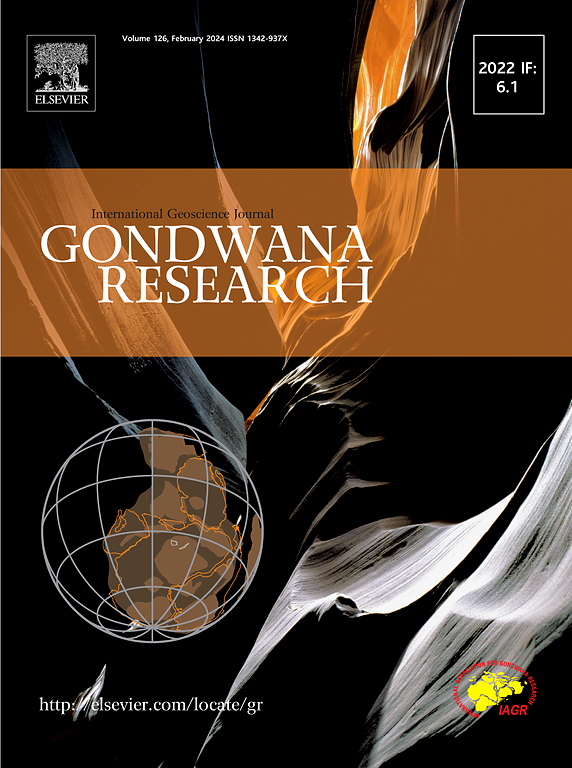Lithospheric architecture of the Curnamona Province, Australia
IF 7.2
1区 地球科学
Q1 GEOSCIENCES, MULTIDISCIPLINARY
引用次数: 0
Abstract
The Curnamona Province in southern Australia is a 90,000 km2 Paleoproterozoic to Mesoproterozoic craton that rifted from the Gawler Craton in the Neoproterozoic and is now separated by the Adelaide Rift Complex sediments in the Flinders Ranges. Magnetotelluric (MT) surveys have been conducted across the Curnamona Province to provide insights on lithospheric architecture. A long-period (10–10,000 s) MT inversion of 136 AusLAMP and legacy long-period MT sites, 134 broadband MT, and 31 geomagnetic depth sounding (GDS) sites over an area 500 km by 500 km is used to create a lithospheric-scale framework for the province. In addition, a crustal-scale broadband (0.01 to 1000 s) MT inversion of 134 sites with closer spacing yields higher fidelity of crustal heterogeneity. The long-period Curnamona Province model is combined with other regional models across southern Australia, encompassing the Archean-Mesoproterozoic Gawler Craton in the west to the Phanerozoic Delamerian and Lachlan Orogens in the east. In this wider context, the Curnamona Province is shown to exhibit four distinct regions of low resistivity. (a) In the top 5 km, resistivity is most strongly influenced by the porosity of sedimentary cover. (b) The upper crust to a depth of 20 km has low resistivity < 1 Ω.m along the eastern margin of the province possibly from organic carbon deposited in the Paleoproterozoic. (c) The lower crust to the Moho (∼40 km) has low resistivity (<100 Ω.m) and is coincident with the extent of the Adelaide Rift Complex suggesting it may have resulted during a period of Neoproterozoic rifting. (d) At sub-continental lithospheric depths of 150–250 km, high electrical conductance in the central to northern part of the Curnamona Province is attributed to metasomatism at the base of the lithosphere in the Mesoproterozoic.

澳大利亚库纳莫纳省的岩石圈结构
澳大利亚南部的Curnamona省是一个90000平方公里的古元古代到中元古代克拉通,它从新元古代的Gawler克拉通中裂出,现在被弗林德斯山脉的阿德莱德裂谷复合体沉积物分开。大地电磁(MT)调查已经在库纳莫纳省进行,以提供岩石圈结构的见解。利用对136个AusLAMP和传统长周期MT站点、134个宽带MT站点和31个地磁测深(GDS)站点的长周期(10-10,000 s) MT反演,在500公里× 500公里的范围内创建了该省的岩石圈尺度框架。此外,对134个测点的地壳尺度宽频带(0.01 ~ 1000 s)大地电磁学反演结果显示,地壳非均质性具有较高的保真度。长周期的Curnamona省模式与澳大利亚南部其他区域模式相结合,西包括太古宙-中元古代的Gawler克拉通,东包括显生宙的Delamerian和Lachlan造山带。在这个更广泛的背景下,Curnamona省显示出四个不同的低电阻率区域。(a)在顶部5公里,电阻率受沉积盖层孔隙度的影响最大。(b) 20 km以下上地壳电阻率<较低;1Ω。古元古代沉积的有机碳在该省东缘形成。(c)下地壳至莫霍(~ 40 km)具有低电阻率(<100 Ω.m),与阿德莱德裂谷杂岩的范围一致,表明它可能是新元古代裂谷作用时期的产物。(d)在150 ~ 250 km的次大陆岩石圈深度,库纳莫纳省中部至北部的高电导率归因于中元古代岩石圈底部的交代作用。
本文章由计算机程序翻译,如有差异,请以英文原文为准。
求助全文
约1分钟内获得全文
求助全文
来源期刊

Gondwana Research
地学-地球科学综合
CiteScore
12.90
自引率
6.60%
发文量
298
审稿时长
65 days
期刊介绍:
Gondwana Research (GR) is an International Journal aimed to promote high quality research publications on all topics related to solid Earth, particularly with reference to the origin and evolution of continents, continental assemblies and their resources. GR is an "all earth science" journal with no restrictions on geological time, terrane or theme and covers a wide spectrum of topics in geosciences such as geology, geomorphology, palaeontology, structure, petrology, geochemistry, stable isotopes, geochronology, economic geology, exploration geology, engineering geology, geophysics, and environmental geology among other themes, and provides an appropriate forum to integrate studies from different disciplines and different terrains. In addition to regular articles and thematic issues, the journal invites high profile state-of-the-art reviews on thrust area topics for its column, ''GR FOCUS''. Focus articles include short biographies and photographs of the authors. Short articles (within ten printed pages) for rapid publication reporting important discoveries or innovative models of global interest will be considered under the category ''GR LETTERS''.
 求助内容:
求助内容: 应助结果提醒方式:
应助结果提醒方式:


